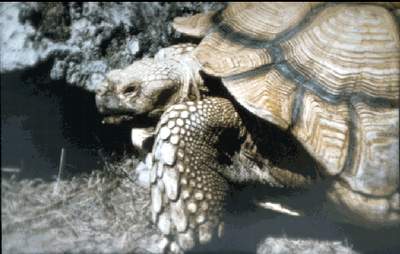HABITAT: An arid country species
RANGE: Central Africa from Mauritania and Senegal to Ethiopia
SUBSPECIES: None
FEATURES: This is the largest mainland tortoise, with some adults reaching over 24 inches (50cms) in length and weighing over 100 lbs (50 kilos). The carapace is serrated; the anal scutes are split with the females having a wider opening than the males. The animal has a wide, rather fl attened carapace, yellow or pale brown in colour. Both limbs and the moderately large head are of the same colour as the carapace. The legs have thick scales and two or three strong gular spurs. The hatchlings have pale yellow carapaces with narrow brown bordered scutes. A 5 year old roughly weighs 40 lbs (20 kilos). Males are larger than females; copulation takes place during the rainy season with the males uttering grunting sounds. Clutches are usually large (between 15 and 30 eggs or even more) and have long incubation times (3-5 months depending on the temperature in the nesting site).
FEEDING:
Native: As an herbivorous tortoise it likes grazing and needs up to 75% of fibre in its diet. It feeds on grass, various succulents, crassulas, thistles and anything else growing in its dry habitat.
Captive: A wide variety of vegetation and some fruits as an occasional treat. Roughage should be offered in the diet (hay and grass) as well as some of the dried Alpine type foods and one of the proprietary vitamin and mineral supplements should be used. Water should be made available as the animal drinks more than in its natural habitat. The following foods can be tried: Meadow hay, dandelions, plantains, clover, sow thistle, watercress, wild mallow, chickweed and other wild growing plants with a high fi bre content as well as a variety of leafy greens.
HUSBANDRY
SUMMER: The Sulcata needs regular exercise and must be given the freedom of a lawn whenever the weather permits. As it grows to a large size it is important the leg muscles have a chance to grow strong. Suitable premises should be provided with a heat source during inclement weather. During summer exposure to unfi ltered sunlight is ideal but supplemental lighting may still be required and is essential during the winter.
WINTER: Suitable premises: a large heated greenhouse or conservatory with solid lower walls, double- walled sheds or rooms with ample natural light. As there is no ultraviolet light from the sun’s radiation to produce vitamin D supplemental lighting will be required. Artifi cial sources produced for reptiles should be used. UV light is split into a number of fractions and it is the UV-b which is required for the vitamin D production so ensure the lamp is producing UV-b. Lamps need to be replaced frequently as the UV light production falls over time and distance from the source. Be careful not to mix this animal with other tortoises as it is susceptible to various diseases carried by animals of temperate climate (Rhinitis or Runny Nose Syndrome, Stomatitis etc). You are advised to keep the animal diurnally, i.e. low night temperatures (about 20 degrees Celsius) and high day temperatures (35 to even 40 degrees Celsius). In its natural habitat the Sulcata burrows and likes to tunnel, so provide burrowing facilities in its outdoor enclosure.
HIBERNATION: The Spurred Tortoise does not hibernate but aestivates in its natural habitat.
(Thank you to those BCG members who filled in the questionnaire on the Sulcata Tortoise, the care sheet is the result of the survey.)
Top

